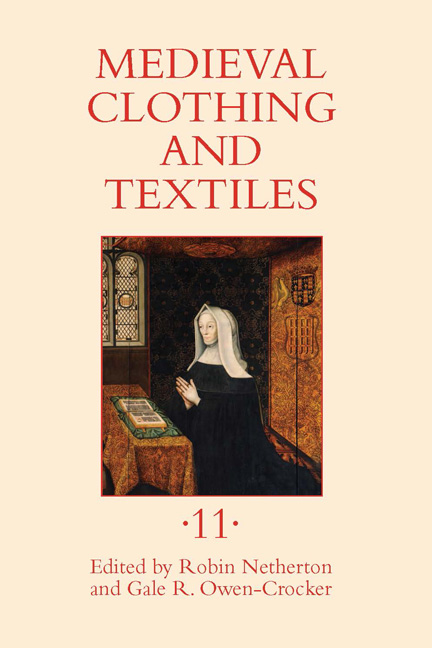Book contents
- Frontmatter
- Contents
- Illustrations
- Tables
- Contributors
- Preface
- 1 Production, Quality, and Social Status in Viking Age Dress: Three Cases from Western Norway
- 2 The Effect of Spindle Whorl Design on Wool Thread Production: A Practical Experiment Based on Examples from Eighth-Century Denmark
- 3 The Shirt Attributed to St. Louis
- 4 Angevin-Sicilian Sumptuary Statutes of the 1290s: Fashion in the Thirteenth-Century Mediterranean
- 5 The Devil on My Tail: Clothing and Visual Culture in the Camposanto Last Judgment
- 6 “Transposing þe shapus þat God first mad them of”: Manipulated Masculinity in the Galaunt Tradition
- 7 Textiles and Dress in the Household Papers of Lady Margaret Beaufort (1443–1509), Mother of King Henry VII
- 8 “Like two artificial gods”: Needlework and Female Bonding in A Midsummer Night's Dream
- Recent Books of Interest
- Contents of Previous Volumes
7 - Textiles and Dress in the Household Papers of Lady Margaret Beaufort (1443–1509), Mother of King Henry VII
Published online by Cambridge University Press: 05 December 2015
- Frontmatter
- Contents
- Illustrations
- Tables
- Contributors
- Preface
- 1 Production, Quality, and Social Status in Viking Age Dress: Three Cases from Western Norway
- 2 The Effect of Spindle Whorl Design on Wool Thread Production: A Practical Experiment Based on Examples from Eighth-Century Denmark
- 3 The Shirt Attributed to St. Louis
- 4 Angevin-Sicilian Sumptuary Statutes of the 1290s: Fashion in the Thirteenth-Century Mediterranean
- 5 The Devil on My Tail: Clothing and Visual Culture in the Camposanto Last Judgment
- 6 “Transposing þe shapus þat God first mad them of”: Manipulated Masculinity in the Galaunt Tradition
- 7 Textiles and Dress in the Household Papers of Lady Margaret Beaufort (1443–1509), Mother of King Henry VII
- 8 “Like two artificial gods”: Needlework and Female Bonding in A Midsummer Night's Dream
- Recent Books of Interest
- Contents of Previous Volumes
Summary
After the Battle of Bosworth in 1485, when Henry Tudor took the crown from Richard III, his mother Lady Margaret Beaufort became the most powerful woman in England. Her son, from whom she had been separated for most of his life but whose right to the throne she had fiercely fought for and eventually achieved (in preference to a claim for herself), rewarded her with land, property, status, and responsibility.
From Collyweston in Northamptonshire, which Lady Margaret developed as her home after 1498, she ruled as quasi-regent of the East Midlands with the aid of her council at Stamford, four miles east of Collyweston. Collyweston was just one of numerous estates in her ownership, some inherited early from her father John Beaufort, Duke of Somerset, and her grandmother Margaret Holland, many the result of her son's 1487 “great grant” of lands derived from the Duke of Exeter (such as her London home of Coldharbour) and the honour of Richmond estates. In the last ten years of her life she also spent considerable time at the manors of Croydon (a residence of the archbishop of Canterbury) and Hatfield (a residence of the bishop of Ely, her stepson James Stanley). These last ten years are of great importance because they were the years of her separation from her last husband, Thomas Stanley, Earl of Derby, and her life as femme sole, in sole charge of her own estates and property and living under a vow of chastity. Stanley remained at his northwestern estates and his wife in the south and east; there is no evidence that she visited Lancashire after their separation, although he stayed with her on several occasions.
The papers relating to these last ten years (1498–1509) are archived at the second of the two Cambridge colleges she founded (Christ's and St. John's) and are currently being edited by the author of this article.
- Type
- Chapter
- Information
- Medieval Clothing and Textiles 11 , pp. 139 - 158Publisher: Boydell & BrewerPrint publication year: 2015



